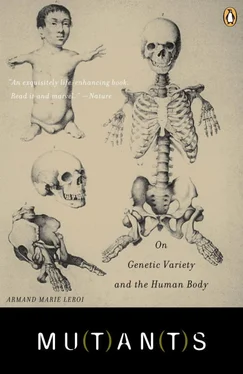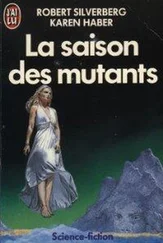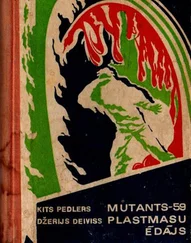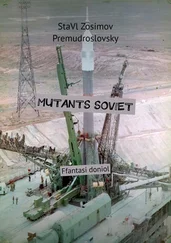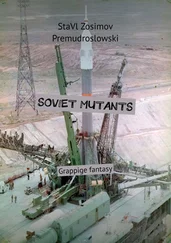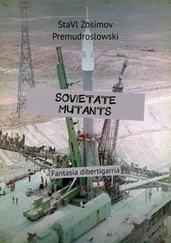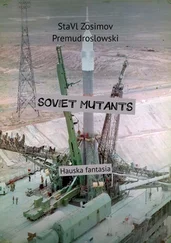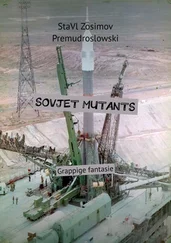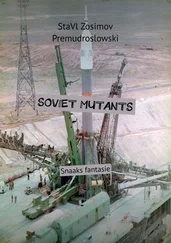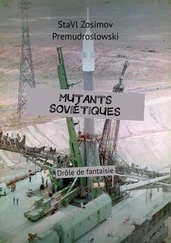Armand Marie Leroi
MUTANTS
On Genetic Variety and the Human Body
My mind is bent to tell of bodies changed to other forms.
OVID,
Metamorphoses
This book is about the making of the human body. It is about the devices that enable a single cell buried in the obscure recesses of the womb to develop into an embryo, a foetus, an infant and finally an adult. It provides an answer provisional and incomplete, yet clear in outline, to the question: how do we come to be?
In part the answer to this question is readily apparent. Our bodies – I hesitate to add our minds – are the products of our genes. At least our genes contain the information, the instruction manual, that allows the cells of an embryo to make the various parts of our bodies. But this answer, so easily given, conceals a world about which we know very little. Genetics, to quote one popular writer on the subject, is a language. ‘It has a vocabulary – the genes themselves – a grammar, the way in which the inherited information is arranged, and a literature, the thousands of instructions needed to make a human being.’ Just so. What he failed to add is that the language of the genes is largely unintelligible.
On 15 February 2001, an international consortium of scientists reported the complete, or nearly complete, sequence of the human genome. We have, we were told, some thirty thousand genes. There it was, arrayed before us, the instruction manual for making a human. Anyone may read this manual – it is freely available on the Web. But it is hardly worth the bother. The average Englishman may as well attempt the Analects of Confucius in the original for all the wisdom that it imparts. Even geneticists find most of its contents baffling. When they scan the genome they find, here and there, words whose meanings are clear enough. The meaning of others can be guessed at, perhaps because they are cognates of more familiar ones. Some of the grammar, the syntactical rules by which genes combine to give their utterances meaning, is understood as well. But the syntax of genes is vastly more complex, more subtle and nuanced, than that of any language spoken by man. And though its literature is not exactly a closed book, it is one we have scarcely begun to read.
It is not that we do not know how to decipher the genome. This book is full of experiments that attempt to do just that. Such experiments usually entail engineering embryos – either by surgically adding or removing organs, or else by adding or removing genes. Of course, the embryos always belong to animals: newts, frogs, chickens and mice. They tell us a great deal about ourselves since, as it happens, the genetic grammars of all creatures are quite similar. But just as, over time, the vocabulary and grammatical rules of human languages diverge from one another in ways large and small, so too do the languages of genes. To learn from animals alone is to run the risk of an error rather like that made by Leonardo da Vinci when he sketched a human foetus attached to what is clearly the placenta of a cow. We need, ultimately, some direct way into the human genome and into the human body. Cleopatra, one source alleges, ordered the dissection of pregnant slave girls so that she could observe the progress of their embryos. While we may admire her curiosity and ability to fit laboratory work into a busy social schedule, we can hardly follow her lead. We must approach the human body more circumspectly. We must find mutants.
I
MUTANTS
[AN INTRODUCTION]
We had heard that a monster had been born at Ravenna, of which a drawing was sent here; it had a horn on its head, straight up like a sword, and instead of arms it had two wings like a bat’s, and the height of its breasts it had a fio [Y-shaped mark] on one side and a cross on the other, and lower down at the waist, two serpents, and it was a hermaphrodite, and on the right knee it had an eye, and its left foot was like an eagle. I saw it painted, and anyone who wished could see this painting in Florence.
IT WAS MARCH 1512, and a Florentine apothecary named Lucca Landucci was writing up his diary. He had much to write about. Northern Italy was engulfed by war. Maximillian of Germany and Louis XII of France were locked in combat with the Spanish, English and Pope Julius II for control of the Venetian Republic. City after city was ravaged as the armies traversed the campagna. Ravenna fell eighteen days after the monster’s birth. ‘It was evident,’ wrote Landucci, ‘what evil the monster had meant for them! It seems as if some great misfortune always befalls the city when such things are born.’

FRONTISPIECE TO FORTUNIO LICETI 1634 DE MONSTRORUM NATURA CAUSSIS ET DIFFERENTIIS.
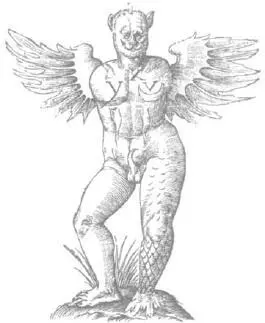
THE MONSTER OF RAVENNA (1512). FROM ULISSE ALDROVANDI 1642 MONSTRORUM HISTORIA.
Landucci had not actually seen the monster. It had been starved to death by order of Julius II, and Landucci’s account is of a drawing that was on public display in Florence. That image was among the first of many. Printed woodcuts and engravings spread the news of the monster throughout Europe, and as they spread, the monster acquired a new, posthumous, existence. When it left Ravenna it had two legs; by the time it arrived in Paris it had only one. In some prints it had bat wings, in others they were more like a bird’s; it had hermaphrodite genitalia or else a single large erection. It became mixed up with the images of another monster born in Florence in 1506, and then fused with a medieval icon of sinful humanity called ‘Frau Welt’ – a kind of bat-winged, single-legged Harpy who grasped the globe in her talons.
As the monster travelled and mutated, it also accreted ever more complex layers of meaning. Italians took it as a warning of the horrors of war. The French, making more analytical effort, interpreted its horn as pride, its wings as mental frivolity and inconstancy, its lack of arms as the absence of good works, its raptor’s foot as rapacity, and its deformed genitalia as sodomy – the usual Italian vices in other words. Some said that it was the child of a respectable married woman; others that it was the product of a union between a nun and a friar. All this allegorical freight makes it hard to know what the monster really was. But it seems likely that it was simply a child who was born with a severe, rare, but quite unmysterious genetic disorder. One can even hazard a guess at Roberts’s syndrome, a deformity found in children who are born with an especially destructive mutation. That, at least, would account for the limb and genital anomalies, if not the two serpents on its waist and the supernumerary eye on its knee.
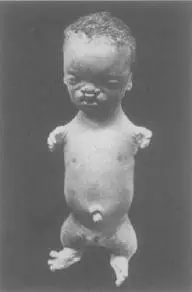
ROBERTS'S SYNDROME. STILLBORN INFANT. FROM B.C. HIRST AND G.A. PIERSOL 1893 HUMAN MONSTROSITIES.
In the sixteenth and seventeenth centuries, monsters were everywhere. Princes collected them; naturalists catalogued them; theologians turned them into religious propaganda. Scholars charted their occurrence and their significance in exquisitely illustrated books. In Germany, Conrad Lycosthenes produced his Prodigiorum ac ostentorum chronicon (1557, later translated as The Doome, calling all men to judgement ); from France came Pierre Boaistuau’s Histoires prodigieuses (History of prodigies, 1560–82) and Ambroise Paré’s Des monstres et prodiges (Monsters and prodigies, 1573). A little later, the Italians weigh in with Fortunio Liceti’s De monstrorum natura caussis et differentiis (On the nature, causes and differences of monsters, 1616) and Ulisse Aldrovandi’s Monstrorum historia (History of monsters, 1642).
Читать дальше
